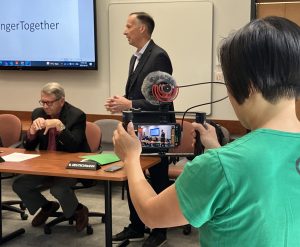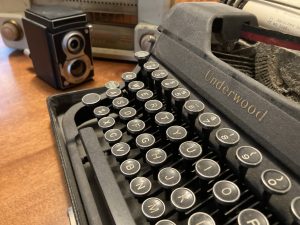Chapter 6: Media Sources

Warm Up Questions
- What media sources do you use each day to find out what is happening in the world?
- How much of an impact do you think media has on your life? In what ways does it influence you?
- Do you think some sources of information are more trustworthy than others? Which ones do you trust the most to give you reliable information?
Key Terms
burning the midnight oil
working late into the night to finish a project or some work
journalist
person who reports the news to others via various media, such as television, radio, newspaper, and internet
magistrate
civil officer or judge for a specific region
Martin Luther
a German priest who, in the early 1500s, questioned the teachings of the Roman Catholic Church, the dominant Christian church at the time, after which a new church began with the Protestant Reformation
medieval
a period of time in European history considered to be between the 4th and 14th centuries
Oyez (Hear Ye)
French (and Old English) expression that directed everyone to listen; often said before an important public announcement
town crier
a person who made public announcements throughout various locations
Reading
1. “OYEZ! OYEZ!” (HEAR YE ! HEAR YE!) if shouted today along with the ringing of a loud bell would create confusion, but in medieval times, that phrase was an important news alert. Let’s go back in time to the origin of news and how it evolved to reach the mass population.
2. In ancient Roman and Greek times, storytellers, history talkers, and news travellers spread the word about current events that affected the people they met. During medieval times, “town criers,“ also known as the “bellmen” and “bell-ringers” delivered official information from the ruling authority to illiterate people living in distant independent territories. The ringing of a bell and the yelling of the Norman-French word “OYEZ!” (HEAR YE!) alerted the public to be quiet and listen to the important news that was about to be announced. This information was the official word generated by higher rulers and given to the local official or magistrate.
Early History of the News
3. In the 15th century, the world began to go through rapid changes. One of the reasons for this evolution was the invention of the printing press by Johannes Gutenberg in the mid-1400s. Gutenberg’s movable type press changed societal structure both by increasing literacy and making the mass production of books achievable. The printing press made it possible for more people to distribute their thoughts and ideology. Books and individual pages could now be mass-printed and widely distributed to a growing literate population. Church doctrine was being challenged by people like Martin Luther, and political change was fueling up as the masses began to obtain information based on new ideas about political rule. After centuries of being told how to think and what to think, a growing number of literate commoners began to question that control.
4. In the 1600s, the printing of books and individual pages was starting to radically change Europe. News of science, wars, politics, and social issues began to circulate and get more attention. The two–page and then multi–page format of a printed newspaper began to grow in popularity throughout Europe. Early newspapers had a purchase price, but when the first sponsorships and advertisers joined in, the profitability of media grew through subscriptions and advertisements. The town crier was no longer the only source for news, and the commoner now had direct access to news and views that differed from that of the ruling powers.
5. The 1800s was an extraordinary time for innovative thinking and technical advances, and the delivery of news was directly affected. The popularity of electricity and its potential uses had scientists and inventors burning the midnight oil to maximize the new–found potentials. Simple wires and circuits made it possible to transmit information in the form of cable-transmitted codes. Morse code made it possible to send electronic information quickly from town to town or across the country.
6. However, the use of coded clicks, taps and pauses soon took a back seat to an even more momentous idea, the transmission of the human voice. The successor to the transmission of information over wire was the telephone. The creation of the telephone meant that news could instantly be sent by human voice across a city, state, or country. While the telephone did not broadcast news to the masses, it did make way for the next era of voice transmission over the air.

Technical Advances Continue to Impact Media
7. In the early 1900s, the first successful radio experiments were taking place. During World War I, wireless telegraphs became vital for communication, and after the war, the wireless research advances continued with successful voice transmission tests in the 1920s. As more transmitters went up, the public could access these signals for both information and entertainment. Printed news was not going away but, while the radio industry grew, it began to compete with printed paper as the prime news source.
8. As inventors saw the successful growth of radio, some were already experimenting with the wireless transmission of a visual image. As better transmission and receiver technology was being developed, the ability to transmit a visual image became a reality, and the television was born. In the 1950s, it was possible for the general public to receive the latest information in their home by printed word, voice radio, or visual images on a television. The growth in news delivery had expanded exponentially within a few decades.
Credibility of News Sources
9. During this era, few people questioned the origin of their news. Everything was believed to be factual and trustworthy, and they could rely on the sources of information. Why would the news be anything but truthful? Why would any company or government agency be anything but honest? If people read it, heard it, or saw it, it was believed to be true. The journalists of that era all appeared to have integrity, as did their sources.
10. But another change was on its way that would begin to bring journalists’ integrity into question. Computers and the internet quickly altered the way we receive information and increased our access to a wide variety of news sources. With the first home computers and public internet access, people could obtain information from anywhere in the world. However, because of this easy access, there were many who began to question the credibility of the sources and the regulation of the news industry.
11. In the past, government regulations were required for newspaper, radio, and television journalism, and if not followed, there could be legal consequences. With the advent of the internet, it became possible for anyone to gather, create, and distribute factual or unverified information with no regulations, no credibility, and no responsibility. The era of “fake news” had arrived along with issues and debates:
- “Why can’t a person publish their own individual ideas? Didn’t Martin Luther do just that thanks to the printing press?”
- “Should a government control the flow of information? Didn’t the town criers follow content rules in medieval Europe?”
Conclusion
12. With access to so much information, the saving grace in today’s world of educated masses falls to one action: the fact check. Anyone can publish unverified news, but the responsibility has fallen on the receiver of this information to check the facts. Are those numbers correct? Are the facts historically accurate and according to whom? Is that photo of a disaster even from the country the source claims it to be? The challenge for the public is not simply to find information, the challenge is to find credible information.
13. In 1500, it was the town crier who would ring a bell to alert and inform us about the official news of our known world. Today, an alert or a “bell” will ring on our mobile device, to tell us of a news event in our known world. The major difference today is that it is our responsibility to ask: “Why am I seeing this?”, “Where did the information come from?”, “Who did it come from?”, and “Is it factual?”.
(1121 words)
Comprehension Questions
- What are some ways that news was delivered to the public during early times? Give at least one example.
- The author mentions several consequences that developed because of the invention of the printing press. Give one example of how the printing press impacted society.
- The delivery of news was affected by increasing technology in the 1800s and 1900s. What are two inventions that impacted the delivery of news during this time?
- What recent inventions significantly changed the way people think about the source of the news they receive? Why do people have to think about their news sources differently?
- What does the author think people need to do to ensure that the information they receive is accurate? Do you agree with the author?
Key Vocabulary
access
accurate
achievable
authority
consequence
expand
format
generate
ideology
innovative
integrity
legal
major
maximize
obtain
publish
prime
radically
regulation
rely
successor
technology
transmit
visual
Vocabulary Practice
This reading was adapted from Molto, P. (2023). History of News. Used with permission from the author. Adaptations include condensing material, reordering paragraphs, and creating comprehension questions.

